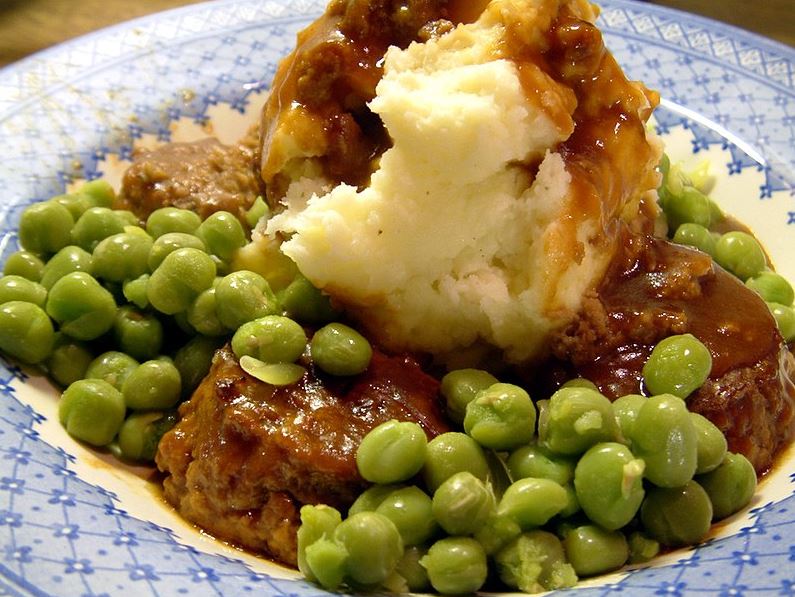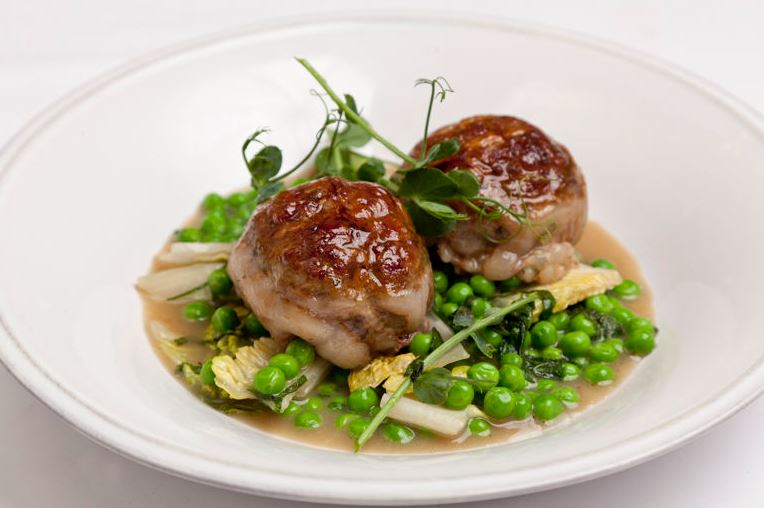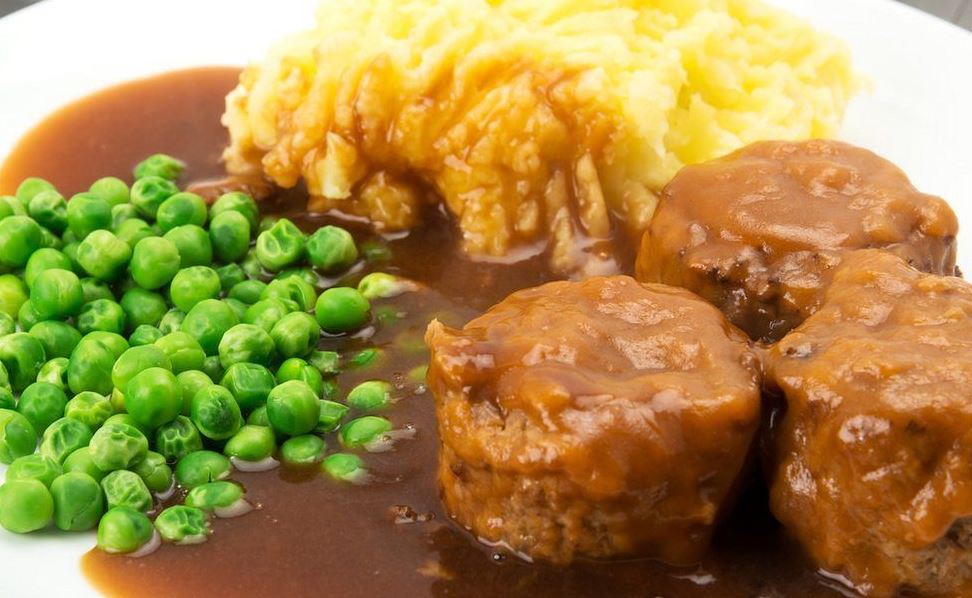Exploring the Traditional British Dish Faggots
Faggots are a quintessential British dish with deep roots in the culinary traditions of the United Kingdom, particularly celebrated in South and Mid Wales and the English Midlands. This hearty meal comprises meatballs made from minced off-cuts and offal, typically pork, including parts like the liver, heart, and sometimes fatty belly meat or bacon. These ingredients reflect a tradition of using all parts of the animal, adhering to a “nose-to-tail” philosophy that has seen a resurgence in modern culinary practices.
Traditionally, the mixture for faggots includes a blend of chopped onions, herbs for flavoring—sage being a common choice—and breadcrumbs, which help bind the ingredients together. The meatballs are then usually wrapped in caul fat, which is the membrane from the pig’s abdomen, adding moisture and richness as they cook. This method not only utilizes more economical cuts of meat but also enriches the dish with deep, savory flavors that are enhanced during the slow cooking process, often in a rich gravy.
Faggots serve as a testament to the ingenuity of past generations who maximized the resources available to them, creating nutritious and flavorful meals from less desirable cuts of meat. The dish’s practical origins and comforting qualities have maintained its popularity over the years, particularly in regions where it originated. Today, while still cherished for its traditional roots, faggots continue to be enjoyed across the UK, both in home kitchens and in restaurants looking to celebrate British heritage and the full spectrum of its native cuisine.
| Aspect | Details |
|---|---|
| Ingredients | Faggots are made from minced off-cuts and offal, typically pork liver, heart, and sometimes fatty belly meat or bacon. They often include chopped onions, sage, and breadcrumbs to bind the ingredients. |
| Preparation | The meat mixture is wrapped in caul fat (the membrane from the pig’s abdomen) and slow-cooked, usually in a rich gravy. This method infuses the faggots with moisture and a rich, savory flavor. |
| Cultural Significance | Originating from South and Mid Wales and the English Midlands, faggots reflect a “nose-to-tail” philosophy, utilizing economical cuts of meat. This dish is a testament to the ingenuity of past generations, creating nutritious and flavorful meals from less desirable cuts. |
| Modern Appeal | While rooted in tradition, faggots continue to be popular across the UK, celebrated in both home kitchens and restaurants for their deep flavors and connection to British culinary heritage. |
Contents
Historical Background
Faggots, a robust and flavorsome dish, trace their origins to the rural heartlands of Western England, notably west Wiltshire and the West Midlands. Historically, faggots were devised as a means to make economical use of lesser cuts of meat and offal, which were often the only options available to the lower economic classes. This dish is deeply rooted in the traditions of English country cooking, where no part of the animal was wasted.

The mid-nineteenth century marked a significant migration of agricultural workers from these rural areas to the burgeoning industrial zones of South Wales. This movement brought about the introduction of faggots to a broader audience, who embraced the dish for its affordability and hearty qualities. The growth of industrial cities provided a new home for faggots, where they became a staple among the working class, sustaining miners and factory workers with a high-energy, nutritious meal.
Faggots are known by various names across different regions of the UK, reflecting the local dialects and culinary traditions. In Yorkshire, Lincolnshire, and Lancashire, the dish is often called “ducks” or “savoury ducks.” The name “faggot” itself first appeared in print in the “Manchester Courier and Lancashire General Advertiser” on Saturday, June 3, 1843, where it was mentioned in a report about a man who had consumed twelve faggots at a sitting. This anecdote not only illustrates the dish’s longstanding presence but also its role in local eating habits and community stories.
| Aspect | Details |
|---|---|
| Origins and History | Faggots originated in the rural areas of Western England, particularly west Wiltshire and the West Midlands. Created as a way to economically use lesser cuts of meat and offal, they are a product of English country cooking traditions where no part of the animal was wasted. |
| Migration and Popularity | The mid-19th century migration of agricultural workers to industrial South Wales introduced faggots to a broader audience. They became a staple for miners and factory workers, providing a high-energy, nutritious meal in industrial cities. |
| Regional Names | In different UK regions, faggots are known by various names such as “ducks” or “savoury ducks” in Yorkshire, Lincolnshire, and Lancashire. These names reflect local dialects and culinary traditions. |
| Historical Mention | The term “faggot” first appeared in print on June 3, 1843, in the “Manchester Courier and Lancashire General Advertiser.” An anecdote mentioned a man who consumed twelve faggots in one sitting, highlighting the dish’s role in local culture and eating habits. |
Preparation and Serving
The classic recipe for faggots includes pork liver and heart, which provide a rich flavor and dense texture. These are typically minced together with onions, herbs—sage being particularly popular—and breadcrumbs, which help to bind the mixture. The use of caul fat, the membrane surrounding the internal organs of the pig, is a traditional method for wrapping the minced meat mixture before cooking. This not only holds the faggots together but also imparts additional moisture and fat, making them juicier and more flavorful as they bake.
Traditionally, faggots are served hot with a side of peas and mashed potatoes, making for a comforting and filling meal. The dish is often accompanied by a rich gravy, which complements the robust flavors of the meatballs. In the Black Country, a region particularly famous for its faggots, the dish is sometimes served with mushy peas, a local favorite.

While pork remains the most traditional base for faggots, variations do exist, including recipes that use beef or even pig’s fry (testicles), offering a different range of flavors and textures. These variations are often regional, reflecting local tastes and ingredient availability. In some recipes, the breadcrumbs may be replaced with cold boiled potatoes, and additional seasonings like mixed herbs and pepper are added to enhance the flavor.
This deep dive into the history and preparation of faggots highlights not only the culinary significance of this traditional dish but also its ability to adapt and endure through centuries. Faggots stand as a testament to the ingenuity of traditional cooking and the rich tapestry of regional food practices across the United Kingdom.
| Aspect | Details |
|---|---|
| Classic Ingredients | Faggots are primarily made from pork liver and heart, minced with onions, herbs (especially sage), and breadcrumbs. The mixture is wrapped in caul fat, which adds moisture and fat during baking, enhancing flavor and juiciness. |
| Traditional Serving | Served hot with mashed potatoes and peas, and often accompanied by a rich gravy. In the Black Country, they are typically served with mushy peas, reflecting local culinary preferences. |
| Variations | While pork is traditional, variations include beef or pig’s fry (testicles), tailored to regional tastes. Some recipes substitute breadcrumbs with cold boiled potatoes and may include additional seasonings like mixed herbs and pepper. |
| Culinary Significance | Faggots are a testament to the ingenuity of traditional cooking, showcasing the adaptability and enduring popularity of regional food practices across the UK. They are a beloved part of the culinary heritage, celebrated for their rich flavors and comforting qualities. |
Production and Modern Popularity Via Video
During World War II, faggots saw a significant rise in popularity across the United Kingdom, largely due to rationing. The dish made efficient use of limited and less desirable cuts of meat, aligning perfectly with the wartime ethos of frugality and making do with available resources. However, in the post-war years, as rationing ended and food choices expanded, the popularity of faggots began to decline. This traditional dish seemed to be fading from British tables until a culinary movement gained momentum in the late 20th and early 21st centuries. The “nose-to-tail eating” trend, which emphasizes using the entire animal to minimize waste, brought faggots back into favor, championed by chefs and food enthusiasts who appreciated both the sustainability and the rich heritage embodied in the dish.
Faggots are now made both at home and commercially, though their preparation stays true to traditional methods. Homemade versions vary slightly with individual family recipes, while commercially produced faggots are often found in British supermarkets and specialty stores, available either fresh or frozen. Traditional butchers’ shops, especially those in areas like the West Midlands, also continue to produce their own versions of faggots, often using locally sourced ingredients and secret family recipes that have been passed down through generations. These small-scale producers play a crucial role in maintaining the authenticity and regional variations of the dish.
| Aspect | Details |
|---|---|
| WWII Popularity | During World War II, faggots became increasingly popular across the UK due to rationing, utilizing limited and less desirable cuts of meat, embodying the wartime ethos of frugality. |
| Post-War Decline | After the war, as rationing ended and food choices expanded, the popularity of faggots began to decline, seeming to fade from British culinary preferences. |
| Resurgence | In the late 20th and early 21st centuries, the “nose-to-tail eating” trend, which focuses on minimizing waste by using the entire animal, helped revive faggots. This movement is supported by chefs and food enthusiasts who value the dish’s sustainability and rich heritage. |
| Modern Production | Faggots are now made both at home and commercially, remaining true to traditional methods. They are available in supermarkets, specialty stores, and traditional butchers’ shops, especially in the West Midlands, often using secret family recipes and locally sourced ingredients. |
Cultural and Social Implications
In the Black Country, an area in the West Midlands known for its rich industrial heritage, faggots remain a beloved symbol of regional identity. Here, they are more than just food; they represent a connection to history and a sense of community. Local butchers and eateries often take pride in their unique recipes, each claiming to have the best or most authentic version. The dish’s ability to bring people together, whether at family tables or community gatherings, underscores its importance in British culinary traditions.

The term “faggot” carries a dual meaning that has led to misunderstandings and controversies, particularly when used outside the UK. In American English, “faggot” is a derogatory term for a homosexual man, a usage that is completely unrelated to the British culinary context. This difference in interpretation has occasionally led to social and media-related challenges. For instance, in 2004, a UK supermarket chain Somerfield aired a radio commercial in which a man remarked, “I’ve got nothing against faggots, I just don’t fancy them.” This play on words, while intended to be humorous within the context of British culture, was found to breach the Advertising and Sponsorship Code for potentially offending listeners, leading to its ban by the industry regulator Ofcom.

Further issues arose in November 2013 when British users of Facebook found themselves temporarily blocked for using the word “faggot” in its culinary sense. The social media platform’s algorithms, designed to prevent hate speech, failed to distinguish between the derogatory and culinary uses of the word, illustrating the challenges of global communication platforms managing language nuances.
These incidents highlight the complex interplay between language, culture, and modern media, underscoring the need for greater cultural awareness and sensitivity. As the global community becomes more interconnected, understanding the context and historical significance of language has never been more critical.
In summary, the production and consumption of faggots not only reflect traditional British culinary practices but also highlight broader social dynamics. Whether considering the resurgence of traditional cooking methods or navigating the complexities of language in a globalized world, faggots provide a fascinating insight into the ongoing evolution of culture and cuisine.
| Aspect | Details |
|---|---|
| Regional Significance | In the Black Country, a region known for its industrial heritage in the West Midlands, faggots are a symbol of regional identity and history. They represent more than food; they embody a connection to community and history, with local butchers and eateries taking pride in their unique recipes. |
| Language and Controversies | The term “faggot” has dual meanings, leading to misunderstandings outside the UK. In American English, it’s a derogatory term for a homosexual man, which is unrelated to its culinary use. Incidents such as the 2004 radio commercial by Somerfield and Facebook’s blocking of the term in 2013 highlight challenges in global communication due to language differences. |
| Global Communication Challenges | Modern media and global platforms sometimes struggle with the nuances of language that have different meanings in different cultures. The incidents involving Somerfield and Facebook underscore the importance of cultural awareness and the need for sensitive language management in global communications. |
| Broader Social Dynamics | The discussions around faggots not only reflect traditional British culinary practices but also illuminate broader social dynamics, including the resurgence of traditional cooking methods and the complexities of language in a globalized world. |
Faggots, a dish steeped in rich history and tradition, hold a significant place within Britain’s culinary heritage. Originating from a practical need to utilize all parts of the animal, faggots have evolved from a humble peasant meal to a beloved symbol of regional pride, particularly in places like the West Midlands and South Wales. Their story is not just about food but also about the resilience and ingenuity of past generations who crafted nourishing meals from limited resources. This historical perspective enriches the dish’s value, making it a culinary artifact that offers insight into the social and economic conditions of earlier times.
The importance of faggots extends beyond their nutritional and historical value; they are a cultural touchstone that connects the present to the past. In regions where they originated, faggots are more than just a menu item; they are a part of the communal identity, often celebrated in local festivals and culinary events. Butchers and chefs who continue to prepare traditional faggots are not merely selling a dish; they are preserving a piece of history, passing down recipes that embody the tastes and techniques of their ancestors.
The potential for continued interest and consumption of faggots is significant, particularly in a culinary landscape that increasingly values sustainable and ethical eating practices. The “nose-to-tail” eating trend, which has seen a resurgence in recent decades, aligns perfectly with the philosophy behind faggots. This movement encourages chefs and home cooks alike to use the entire animal, reducing waste and respecting the resources provided by livestock. Faggots, which utilize off-cuts and offal that might otherwise be discarded, exemplify this approach, offering a sustainable option that also connects eaters with traditional cooking methods.
Moreover, the ongoing interest in regional and traditional foods among food enthusiasts around the world suggests that dishes like faggots have a ready and receptive audience. As people become more interested in the origins of their food and the stories behind traditional dishes, the appeal of faggots is likely to grow. Food tourism, which encourages visitors to explore local cuisines and culinary histories, provides another avenue for the promotion and appreciation of faggots. This interest in authentic, local eating experiences can drive the revitalization of traditional dishes, ensuring their place in contemporary cuisine.
Culinary preservation efforts also play a crucial role in maintaining the relevance of traditional foods like faggots. By documenting recipes, techniques, and the history associated with dishes, culinary historians, and chefs help ensure that these traditions are not lost to time. Educational programs that teach the preparation and significance of traditional dishes can also foster a deeper appreciation and understanding among younger generations, ensuring that they too understand and value their culinary heritage.
In conclusion, faggots are more than just a traditional British dish; they are a symbol of cultural resilience, culinary innovation, and the importance of sustainable practices in cooking. The continued interest in and consumption of faggots are supported by both a return to traditional eating practices and a broader global trend towards culinary heritage and sustainability. As we move forward, embracing these aspects of our culinary past can enrich our present dining experiences and ensure that valuable food traditions continue to thrive and evolve. Thus, faggots stand poised not only to remain a part of Britain’s culinary landscape but to inspire and inform sustainable culinary practices worldwide.
Knowledge -Exploring the Many Facets of Camou
The Evolution of the Primary School Leaving Examination
Newkirk Plaza Station A Century of Service and Renovation
Versatility of the Term Droopsnoot From Aircraft
Canna tuerckheimii A Vibrant Addition to the Cannaceae
Fifth Street Asset Management A Comprehensive Overview
Exploring My Life as a Teenage Robot A Comprehensive Guide